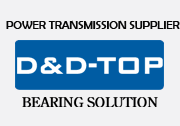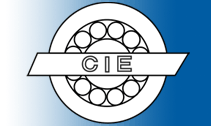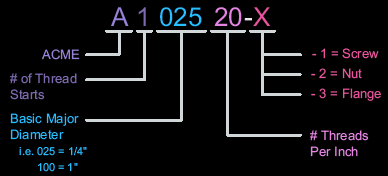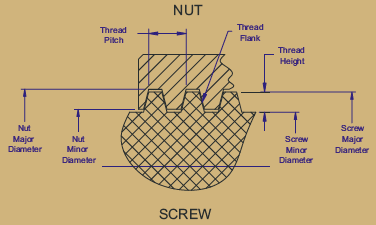| / We will do attentively.. | Collection / Supposes / E-mail / Site map |

|

| Industry News | |||||||
|
| Current Location: Home >> Power Transmission Technology >> ACME Screw Data |
| Power Transmission Technology |
| ACME Screw Data | Ball Screw Data | Ball Screw Selection | Bearing Mounts Data | Design And Engineering |
| Linear Guides | Linear Guideway Info | RFQ of Linear Guider Rail And Block |
| The R/B/S line of ACME screw products has been designed and manufactured to provide an economical means for converting angular/rotational motion to linear/translational motion. The R/B/S standard line of ACME screws are produced to General Purpose-2G tolerances from excellent quality materials. The following technical information section will start by describing R/B/S ACME nomenclature, followed by illustrating and defining basic ACME thread terminology, and finish with technical design definitions, constraint parameters, and mechanical equations that govern safe screw operation and selection. |
Nomenclature |
The following section describes the part number nomenclature for ordering ACME products. |
Terminology |
|
Pitch Diameter |
the theoretical diameter described dimensionally by the mean value of the major and minor diameters. |
Thread Height |
half the difference between the major and minor diameters. The basic thread height is equal to one half of the thread pitch. The basic thread height is also equal to the thread thickness at the pitch diameter. |
Thread Lead |
the nominal translational distance produced by one turn of the thread. The lead is equal to the SCREW PITCH x THE NUMBER OF STARTS. Therefore, the lead = pitch for single start threads. |
Thread Pitch |
nominal distance between the same points on adjacent thread forms as measured parallel to the rotational axis. |
Threads Per Inch |
equal to the reciprocal of the pitch. |
Thread Starts |
the number of uniquely independent threads contained either on the screw or the nut. |
Thread Flank |
the area of contact between the nut thread and the screw thread. |
End Fixity |
Four basic combinations of end fixity are commonly utilized. The fixity basically describes the bearing configuration being used to support the rotational axis of the screw. The four typical combinations of end fixity include: fixed-free, both ends simple, one end fixed and the other end simple, and both ends fixed. |
|
|
Technical |
This section has been compiled to present crucial information, definitions, constraint parameters, and mechanical equations that are necessary for selecting the appropriate product for a given set of applicable variables. Some of these systemic constraints and variables would include items such as: critical speed, compressive column loading, the dynamic motion profile, applied dynamic loading, driving torque, angular acceleration, systemic efficiency, end fixity restraint, and others. These topics and others as applicable will be discussed further in the following text. |
Applied Dynamic |
Each unique application needs to be evaluated such that ALL force components are realized and accounted for. The force components might include: weight of the sliding mechanism (if vertical), weight of the sliding mechanism multiplied by the coefficient of sliding friction (if horizontal), any direct forces resisting the linear motion, and any other applicable force components. It is important to understand that ACME screws are only intended to be subjected to compressive and/or tensile loads being applied parallel and concentric to the rotational axis of the screw. Moment and side loading of the nut need to be avoided as wedging of the nut on the screw can occur. |
|
|
Screw RPM at |
NOTE for below: Compare the calculated screw RPM to the critical speed value to determine if the below RPM is attainable. |
|
|
Critical Speed |
By definition, critical speed is the theoretical angular velocity, in revolutions per minute, which excites the natural frequency of the screw. As the critical speed approaches the screw’s natural frequency, the screw shaft begins to resonate which leads to excessive systemic vibration. The resulting resonance occurs regardless of screw orientation. R/B/S recommends limiting the maximum recommended angular velocity to 80% of the calculated critical speed value. |
|
|
Column Load |
The ability of the screw to withstand compressive forces is determined by the following column load strength calculation. The fundamental limit occurs when a compressive load exceeds the elastic stability of the screw shaft. The subsequent failure is caused by the resultant bending or buckling. The column load strength needs to be evaluated in concert with the screws slenderness ratio. The column load strength parameter only applies to compressive loading and not to tensile loading (based on Euler’s formula). |
|
|
Torque for Motion |
The equation below only determines the required torque to maintain a constant velocity for the applied load as reflected to the drive end of the screw. The peak system torque would need to account for all of the pertinent torque required to accelerate the load, the constant torque value, any mechanical gearing ratios, angular inertias, and other specific characteristics of each unique application. |
|
|
| Workshop | Products | Contact |
| Copyright © NINGBO CIE INDUSTRY AND TRADE CO.,LTD. All Rights Reserved. Design By HiSupplier Online Inc. |


 The following illustration visually depicts and augments the subsequent definitions.
The following illustration visually depicts and augments the subsequent definitions.



